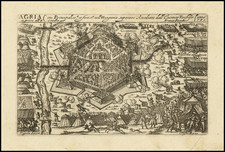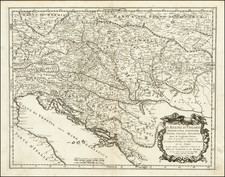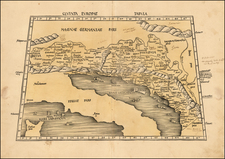Beautiful manuscript map of Buda and Peste, showing the city besieged by a 1686 Hapsburg-led coalition.
The Siege of Buda, one of the major turning points in the Hapsburg-Ottoman wars, was characterized by huge armies and large losses. Here, the attacking positions are shown surrounding the city on all sides on the west bank of the city. Peste ("Pesth") is shown across the river, not subject ot the siege. Topography and other features are shown.
The map is drawn in the classic French military style, which emphasized accuracy and military usefulness. This drawing was executed at some point in the middle of the 18th century, suggesting that it was used to study the classic battle.
The 1686 Siege of Buda
The Siege of Buda was a significant confrontation that took place during the Great Turkish War, when the forces of the Holy League, a coalition of European powers, sought to retake the strategic city from the control of the Ottoman Empire. Since 1541, Budapest, then divided into Buda and Pest on either side of the Danube River, had been under Ottoman control, serving as a pivotal stronghold in Central Europe.
The siege began in the summer of 1686 when the Holy League, which included forces from the Holy Roman Empire, Poland, Venice, and Russia, among others, turned its attention to Budapest. The Ottoman forces, under the command of Grand Vizier Kara Mustafa Pasha, fortified themselves within the Buda Castle. The Holy League forces, a multinational assembly led by Charles V, Duke of Lorraine, initiated a two-month-long siege against the stronghold, marked by fierce combat and artillery barrages.
The climactic point of the siege occurred in mid-September 1686 when the forces of the Holy League launched a full-scale assault on the castle. Despite fierce resistance from the Ottoman defenders, the attackers managed to breach the castle's walls and swarm into the fortress. In the ensuing battle, the Ottoman forces suffered significant losses and were ultimately compelled to surrender. The takeover of the city by Christian forces was particularly brutal, and much of the Jewish and Muslim population of the city was massacred.
The successful recapture of Budapest marked a decisive shift in the balance of power in the Great Turkish War. It signaled the beginning of the end of Ottoman domination in Central Europe and marked a crucial turning point in the Habsburg-Ottoman rivalry.











![[Nové Zámky / Érsekújvár, Slovakia] La famosissima Piazza di Neuhausel nelli Confini di Ungaria assediata da Turchi li 13 Agosto 1663](https://storage.googleapis.com/raremaps/img/small/75781.jpg)


![[Szigetvár] Ziget, fortezza innespugnabile, si come ogi di è veramente situata . . . M.D. LXVI](https://storage.googleapis.com/raremaps/img/small/92144.jpg)